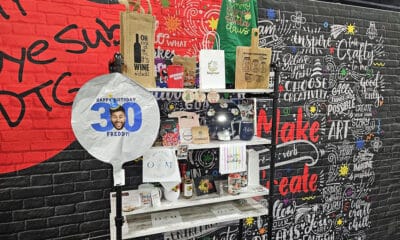The European manufacturers’ association ESMA, capitalizing on the growing understanding that industrial applications are very much a part of the commercial printing industry, had its most extensive presence yet at drupa 2016 in Düsseldorf. ESMA organized themed pavilions in two halls, produced educational seminars, made a team of experts available to attendees at its booth throughout the show, and more. We caught up with ESMA CEO Peter Buttiens after the exhibition.
The European manufacturers’ association ESMA, capitalizing on the growing understanding that industrial applications are very much a part of the commercial printing industry, had its most extensive presence yet at drupa 2016 in Düsseldorf. ESMA organized themed pavilions in two halls, produced educational seminars, made a team of experts available to attendees at its booth throughout the show, and more. We caught up with ESMA CEO Peter Buttiens after the exhibition.
Screen Printing: Screen printing was always part of drupa, but its presence in the exhibition began to decline around the turn of the century. Was this one of the reasons that ESMA took a more active role beginning in 2012?
Peter Buttiens: Founded in 1990 by a group of screen-printing suppliers, ESMA’s role was to prepare the sector for challenging and disruptive digital technologies. It was our main objective to ensure and promote the possibilities of the screen-printing process, and over the years, it became clear that for many functional and speciality applications, screen is the leading technique.
Since 2012, ESMA has been growing stronger with the dedication of member companies and partners. Our closer relationship with Messe Düsseldorf has resulted in pavilions not just at drupa, but other shows like glasstec and K. ESMA has also been appointed the PEPSO partner of Messe Düsseldorf, taking on a supporting role for several exhibitions which aim to expand the implementation of printed electronics in new areas. Regarding drupa 2016, our pavilion in hall 3 stood in the center of attention for all functional screen-printing applications, and it was larger than the one at the last show in 2012, as many members realized the value of getting more exposure when exhibiting together.
Advertisement
SP: The organizers have made a concerted effort to expand into industrial applications that were historically outside the scope of drupa. Did the attendees this year seem more aware of functional printing and the range of applications that were highlighted in the ESMA pavilions?
PB: Yes. The industrial applications had already received more attention in 2012, but screen printing has reinvented itself as more of a manufacturing process, as we call it “print for production.” The need for functional or industrial printing has been growing quickly because it supports many of the “hot” applications from the printed electronics area: antennas (RFID, NFC), touch panels, contacts, smart sensors, smart tags, and much more.
SP: Would you say ESMA’s main objective is to bring the industrial printing audience to Düsseldorf, or to educate the broader printing industry of the range of things that can be done with screen and digital printing?
PB: These are two goals that we target during each exhibition. We have developed five highly technical conferences (all in Düsseldorf) and keep developing new topics for them, which continues to bring together key players from across the entire supply chain. This is where market meets technology and they both learn from each other. One example came from big pharmaceutical companies which are taking a closer look at biomedical printing of diagnostic kits. It was discussed both at our AFIP conference in March and at drupa. It’s a huge opportunity for functional printing, considering that the diabetic testing strips market alone is worth $5 billion today.
SP: Overall, your impressions of drupa?
PB: Drupa 2016 was a success for ESMA as many visitors found their way to our booth to ask questions about printed electronics, conductive inks, and new developments. We could provide them with answers and practical orientation by directing them to our members who have the solutions but are not necessarily known for these applications. ESMA will definitely return in 2020. It is clear that printing has become much more than putting ink on paper. From industrial decoration to functional printing, we are witnessing a fascinating and major shift in the printing industry.
Advertisement
Read more from our August/September 2016 issue.

 Case Studies2 months ago
Case Studies2 months ago
 Art, Ad, or Alchemy2 months ago
Art, Ad, or Alchemy2 months ago
 Andy MacDougall2 months ago
Andy MacDougall2 months ago
 Columns3 weeks ago
Columns3 weeks ago
 Editor's Note3 weeks ago
Editor's Note3 weeks ago
 Marshall Atkinson3 weeks ago
Marshall Atkinson3 weeks ago
 Thomas Trimingham2 months ago
Thomas Trimingham2 months ago
 News & Trends2 months ago
News & Trends2 months ago
















